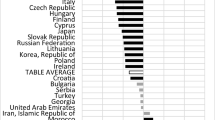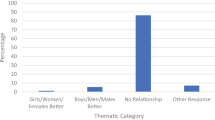Abstract
The purpose of this study was to investigate gender differences in students’ mathematics achievement and in their attitudes toward mathematics. Another purpose was to examine mathematics teachers’ beliefs and their perceptions of their male and female students’ ability. The sample consisted of 692 students (353 girls, 339 boys) between the ages of 12 and 16 years, enrolled in grades 7–9 at four private schools in Lebanon. Data were collected using the Attitudes Toward Mathematics (ATM) scale (Aiken in Journal for Research in Mathematics Education, 5, 67–71, 1974), school records, and interviews with teachers. Results showed no significant gender differences in either achievement or attitudes toward mathematics, thus dispelling the common belief that female students in traditional cultures do not perform well in mathematics and dislike the field. A main effect for grade level was found with ninth graders significantly outperforming their younger counterparts. Also, teachers viewed mathematics as a male domain and attributed boys’ success to ability and girls’ success to effort. They also interacted with boys more frequently regardless of the nature of the exchange. Implications for future research and for instructional practice are overviewed.
Similar content being viewed by others
References
Aiken, L. R. (1974). Two scales of attitude toward mathematics. Journal for Research in Mathematics Education, 5, 67–71.
Ayyash-Abdo, H. (2007). Adolescence in Lebanon. In J. J. Arnett (Ed.), International encyclopedia of adolescence (pp. 583–590). London: Routledge.
Ayyash-Abdo, H., Bahous, R., & Nabhani, M. (2009). Educating young adolescents in Lebanon. In V. Anfara, S. Merten, & K. Roney (Eds.), Handbook of research in middle level education: An international look at educating young adolescents (pp. 25–46). Chapel Hill: Information Age Publishing.
Bahous, R., & Nabhani, M. (2008). Improving schools for social justice in Lebanon. Improving Schools, 11, 127–141.
Beaman, R., Wheldall, K., & Kemp, C. (2006). Differential teacher attention to boys and girls in the classroom. Educational Review, 58(3), 339–366. doi:10.1080/00131910600748406
Brandell, G., & Staberg, E. M. (2008). Mathematics: A female, male or gender-neutral domain? A study of attitudes among students at secondary level. Gender and Education, 20, 495–509.
Cai, H., Luo, Y., Shi, Y., Liu, Y. & Yang, Z. (2016). Male=science, female=humanities: Both implicit and explicity gender-science stereotypes are heritable. Social Psychological and Personality Science, 7(5), 412–419. doi:10.1177/1948550615627367
Chapman, E. (2003). Development and validation of a brief mathematics attitude scale for primary-aged students. Journal of Educational Enquiry, 4(2), 63–73.
Fennema, E., Peterson, P. L., Carpenter, T. P., & Lubinski, C. A. (1990). Teachers’ attributions and beliefs about girls, boys, and mathematics. Educational Studies in Mathematics, 21, 55–69.
Fennema, E., & Sherman, J. A. (1976). Fennema-Sherman mathematics attitude scale: Instruments designed to measures attitudes toward the learning of mathematics by females and males. Psychological Documents, 6(2), (ms. no. 1225).
Forgasz, H., Leder, G., & Tan, H. (2014). Public views on the gendering of mathematics and related careers: International comparisons. Educational Studies in Mathematics, 87, 369–388. doi:10.1007/s10649-014-9550-6
Georgiou, S. N., Stavrinides, P., & Kalavana, T. (2007). Is Victor better than Victoria at mathematics? Educational Psychology in Practice, 23, 329–342.
Gherasim, L. R., Butnaru, S., & Mairean, C. (2013). Classroom environment, Achievement Goals and mathematics performance: Gender differences. Educational Studies, 33, 1–12.
Gonzales, P., Williams, T., Jocelyn, L., Roey, S., Kastberg, D., & Brenwald, S. (2008). Highlights from TIMSS 2007: Mathematics and science achievement of U.S. fourth- and eighth-grade students in an international context. (NCES 2009–001Revised). Washington, DC: National Center for Education Statistics, Institute of Education Sciences, U.S. Department of Education.
Halpern, D. F. (2012). Sex differences in cognitive abilities. New York: Taylor & Francis.
Hamzeh, E. (2009). Lebanese middle school students’ attitudes toward mathematics as a subject and toward mathematics teachers (Unpublished master’s thesis). Lebanese American University, Beirut, Lebanon.
Hanna, G. (2003). Reaching gender equity in mathematics education. The Educational Forum, 67, 204–214.
Hassan, K. (2001). Gender issues in achievement in Lebanon. Social Behaviour and Personality, 29, 113–124.
Heilbronner, N. M. (2013). The STEM pathway for women: What has changed? Gifted Child Quarterly, 57, 39–55.
Helwig, R., Anderson, L., & Tindal, G. (2001). Influence of elementary student gender on teachers’ perceptions of mathematics achievement. The Journal of Educational Research, 95, 93–102.
Hoepfl, M. C. (1997). Choosing qualitative research: A primer for technology education researchers. Journal of Technology Education, 9(1), 47–63.
Hoffman, M., Gneezy, U., & List, J. (2011). Nurture affects gender differences in spatial abilities. PNAS, 108, 14785–14788. doi:10.1073/pnas.1015182108
Hyde, J. S. (2005). The gender similarities hypothesis. American Psychologist, 60(6), 581–592.
Ingalhalikar, M., Smith, A., Parker, D., Satterthwaite, T. D., Elliott, M. A., Ruparel, K., et al. (2014). Sex differences in the structural connectome of the human brain. PNAS, 11(2), 823–828.
Kelly, A. (1988). Gender differences in teacher–pupil interactions: A meta-analytic review. Research in Education, 39, 1–24.
Leahy, E., & Guo, G. (2001). Gender differences in mathematical trajectories. Social Forces, 80(2), 713–732.
Li, Q. (1999). Teachers’ beliefs and gender differences in mathematics: A review. Educational Research, 41, 63–76.
Lindberg, S. M., Hyde, J. S., Petersen, J. L., & Linn, M. C. (2010). New trends in gender and mathematics performance: A meta-analysis. Psychological Bulletin, 136(6), 1123–1135. doi:10.1037/a0021276
Merrett, F., & Wheldall, K. (1992). Teachers’ use of praise and reprimands to boys and girls. Educational Review, 44(1), 73–80.
Myhill, D. (2002). Bad boys and good girls? Patterns of interaction and response in whole class teaching. British Educational Research Journal, 28, 340–352.
Nosek, B. A., Smyth, F. L., Srirama, N., Lindner, N. M., Devos, T., Ayala, A., et al. (2009). National differences in gender-science stereotypes predict national sex differences in science and math achievement. PNAS, 106, 10593–10597. doi:10.1073/pnas.0809921106
Patrick, H., Turner, J. C., Meyer, D. K., & Midgley, C. (2003). How teachers establish psychological environments during the first days of schools: Associations with avoidance in mathematics. Teachers College Record, 105(8), 1521–1558.
Preckel, F., Goetz, T., Pekrun, R., & Kleine, M. (2008). Gender differences in gifted and average-ability students. Gifted Child Quarterly, 52, 146–159.
Robinson, J. P., & Lubinski, S. T. (2011). The development of gender achievement in mathematics and reading during elementary and middle school: Examining, direct cognitive assessments and teacher ratings. American Educational Research Journal, 48, 268–302.
Sarouphim, K. M. (2009). The use of a performance assessment for identifying gifted Lebanese students: Is DISCOVER effective? Journal for the Education of the Gifted, 33, 276–296.
Sarouphim, K. M. (2010). A model for the education of gifted learners in Lebanon. International Journal of Special Education, 25(1), 71–79.
Sarouphim, K. M. (2011). Gifted and non-gifted Lebanese youth: Gender differences in self-concept, self-esteem and depression. International Education, 41, 26–41.
Sarouphim, K. M. (2015). Slowly but surely: Small steps toward establishing gifted education programs in Lebanon. Journal for the Education of the Gifted, 38(2), 196–211. doi:10.1177/0162353215578278
Stoet, G. E., & Geary, D. D. (2013). Sex differences in mathematics and reading achievement are inversely related: Within- and across-nation assessment of 10 years of PISA data. PLoS ONE, 8(3), e57988. doi:10.1371/journal.pone.0057988
Tapia, M., & Marsh, G. E. (2004). An instrument to measure mathematics attitudes. Academic Exchange Quarterly, 8(2), 16–21.
Tiedemann, J. (2000). Gender-related beliefs of teachers in elementary school mathematics. Educational Studies in Mathematics, 41(2), 191–207.
Tsui, M. (2007). Gender and mathematics achievement in China and the United States. Gender Issues, 24, 1–11.
Turner, J. C., Meyer, D. K., Anderman, E. M., Midgley, C., Gheen, M., Kang, Y., et al. (2002). The classroom environment and students’ reports of avoidance strategies in mathematics: A multimethod study. Journal of Educational Psychology, 94(1), 88–106.
United Nations. (2001). Review of the youth situation in the ESCWA region. Economic and social commission for Western Asia. Retrieved April 15 2005 from www.escwa.org.1, Society, 21, 331–343.
United Nations Economic and Social Commission for Western Asia. (2002). Women and men in Lebanon: A statistical portrait. Beirut: ESCWA.
Villalobos, A. (2009). The importance of breaking set. Theory and Research in Education, 7, 27–45.
Weis, L., et al. (2015). In the guise of STEM education reform: Opportunity structures and outcomes in inclusive STEM-focused high schools. American Educational Research Journal, 52, 1024–1059. doi:10.3102/0002831215604045
World Bank. (2002). Exploring countries and regions. Retrieved November 8 2005 from http://www.worldbank.org/html/schools/regions/mena/Lebanon.htm
Zouein, G. (2003). Lebanon: System of education. In T. Husen & T. N. Postlethwaite (Eds.), The international encyclopedia of education (pp. 3349–3356). New York: Pergamon.
Author information
Authors and Affiliations
Corresponding author
Rights and permissions
About this article
Cite this article
Sarouphim, K.M., Chartouny, M. Mathematics education in Lebanon: gender differences in attitudes and achievement. Educ Stud Math 94, 55–68 (2017). https://doi.org/10.1007/s10649-016-9712-9
Published:
Issue Date:
DOI: https://doi.org/10.1007/s10649-016-9712-9




